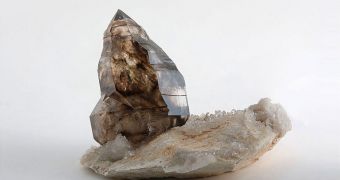Experts were finally able to shed some light on a complex geological puzzle that has been keeping this field of research from progressing for decades. The team, based in the UK, found that quartz crystals play a fundamental role in underlying the behavior of tectonic plates.
Our planet is formed from three layers, that are stacked atop each other. The inner and outer core are at the center, and are surrounded by the mantle. This is layer of viscous, molten rock, on which the Earth crust lies.
The crust is made up of segments called tectonic plates – that provide support for continents and oceans – which glide atop the molten mantle, and interact with each other by colliding or moving further apart.
This theory was founded some four decades ago by Tuzo Wilson,a pioneering tectonic geophysicist. His work inspired the development of the “Wilson Tectonic Cycle,” which set the foundation for the modern view on plate tectonics.
His main point of view, expressed in a landmark paper published in the top journal Nature, was that the ocean basins simply opened and closed along North America's eastern seaboard, at various intervals.
Wilson proposed that the event happened several times in the 4.6 billion years the Earth has been around, most recently when the giant supercontinent Pangaea split into the seven smaller continents our planet displays today.
After this work was published, studies conducted with more modern means have confirmed it, showing that continents are literally deformed at a large scale. These variations are only produced at certain regions around the globe, and rarely elsewhere. Experts had no idea why that happened until now.
In the new research, carried out by a team of experts in the US and the UK, it was determined that the rock cycles Wilson had hinted at are heavily influenced by quartz in the deep planetary crust.
Utah State University geophysicist Tony Lowry collaborated closely with Royal Holloway, University of London investigator Marta Pérez-Gussinyé to arrive at these conclusions. The group published its findings in the March 17 issue of the top journal Nature.
“It all begins with quartz,” Lowry explains, adding that the crystal plays a critical role in triggering the chain of events that eventually spreads so much that is causes cracks, wrinkles and folds to develop in Earth's crust. These go on to form valleys, plains and mountain chains.
“If you've ever traveled westward from the Midwest's Great Plains toward the Rocky Mountains, you may have wondered why the flat plains suddenly rise into steep peaks at a particular spot,” Lowry adds.
“It turns out that the crust beneath the plains has almost no quartz in it, whereas the Rockies are very quartz-rich,” the expert explains. In other words, mountains can only be produced from beneath if a rich deposit of quartz exists under the crust.
"Earthquakes, mountain-building and other expressions of continental tectonics depend on how rocks flow in response to stress. We know that tectonics is a response to the effects of gravity, but we know less about rock flow properties and how they change from one location to another,” the expert argues.
Even after compensating for the influences that water, temperature and pressure may have on the formation of new mountains, the experts still determined that quartz played a critical role.
“This intriguing study provides new insights into the processes driving large-scale continental deformation and dynamics,” explains Greg Anderson, who is the EarthScope program director at the US National Science Foundation (NSF).

 14 DAY TRIAL //
14 DAY TRIAL //